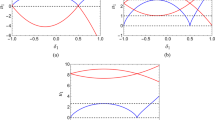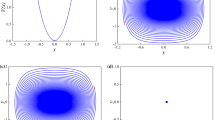Abstract
In the current paper, we have investigated the generalized FitzHugh–Nagumo model. We have shown that symmetric bursting behaviors of different types could be observed in this model with an appropriate recovery term. A modified version of this system is used to construct bursting activities. Furthermore, we have shown some numerical examples of delayed Hopf bifurcation and canard phenomenon in the symmetric bursting of super-Hopf/homoclinic type near its super-Hopf and homoclinic bifurcations, respectively.

















Similar content being viewed by others
References
Baer SM, Erneux T, Rinzel J (1989) The slow passage through a Hopf bifurcation: delay, memory effects, and resonance. SIAM J Appl Math 49:55–71
Benes GN, Barry AM, Kaper TJ, Kramer MA, Burke JM (2011) An elementary model of torus canards. Chaos 21:023131
Booth V, Carr TW, Erneux T (1997) Near threshold bursting is delayed by a slow passage near a limit point. SIAM J Appl Math 57:1406–1420
Chay TR, Keizer J (1983) Minimal model for membrane oscillations in the pancreatic beta-cell. Biophys J 42:181–190
Curtu R, Rubin J (2011) Interaction of canard and singular Hopf mechanisms in a neural model. SIAM J Appl Dyn Syst 10(4):1443–1479
Desroches M, Krauskopf B, Osinga HM (2008) Mixed-mode oscillations and slow manifolds in the self-coupled FitzHugh Nagumo system. Chaos 18(1):015107
DeVries G (1998) Multiple bifurcations in a polynomial model of bursting oscillations. J Nonlinear Sci 8:281–316
Dolnik M, Epstein IR (1993) A coupled chemical burster: the chlorine dioxide-iodide reaction in two flow reactors. J Chem Phys 98:1149–1155
Ermentrout B (2002) Simulating, analyzing, and animating dynamical systems (A guide to XPPAUT for researchers and students). Siam Society for Industrial and Applied Mathematics, Philadelphia
Ermentrout GB, Terman D (2010) Mathematical foundations of neuroscience. Springer, New York
FitzHugh R (1969) Mathematical models for excitation and propagation in nerve. In: Schawn HP (ed) Biological engineering. McGraw-Hill, New York
Georgiev NV (2003) Identifying generalized FitzHugh–Nagumo equation from a numerical solution of Hodgkin–Huxley model. J Appl Math 8:397–407
Gong PL, Xu JX (2001) Global dynamics and stochastic resonance of the forced FitzHugh–Nagumo neuron model. Phys Rev E 63:031906
Govaerts W, Dhooge A (2002) Bifurcation, bursting and spike generation in a neural model. Int J Bifurcat Chaos Appl Sci Eng 12(8):1731–1741
Guckenheimer J, Kuehn C (2009) Computing slow manifolds of saddle type. SIAM J Appl Dyn Syst 8(3):854–879
Han X, Jiang B, Bi Q (2010) 3-torus, quasi-periodic bursting, symmetric subHopf/fold-cycle bursting, subHopf/fold-cycle bursting and their relation. Nonlinear Dyn 61:667–676
Hindmarsh JL, Rose RM (1984) A model of neuronal bursting using three coupled first order differential equations. Proc R Soc Lond Biol 221:87–102
Hodgkin A, Huxley A (1952) A quantitative description of membrane current and its application to conduction and excitation in nerve. J Physiol (Lond.) 117:500–544
Izhikevich EM (2000) Neural excitability, spiking, and bursting. Int J Bifurcat Chaos 10:1171–1266
Izhikevich EM (2004) Which model to use for cortical spiking neurons? IEEE Trans Neural Netw 15:1063–1070
Izhikevich EM (2007) Dynamical systems in neuroscience: the geometry of excitability and bursting. MIT Press, Cambridge
Kinney WM (2000) An application of Conley index techniques to a model of bursting in excitable membranes. J Diff Equ 162:451–472
Kinney WM (2008) Applying the Conley index to fast-slow systems with one slow variable and an attractor. J Math 38(4):1177
Kramer M, Traub R, Kopell N (2008) New dynamics in cerebellar purkinje cells: torus canards. Phys Rev Lett 101:68103
Krupa M, Szmolyan P (2001) Extending geometric singular perturbation theory to nonhyperbolic points–fold and canard points in two dimensions. SIAM J Math Anal 33:286–314
Lee E, Terman D (1999) Uniqueness and stability of periodic bursting solutions. J Diff Equ 158:48–78
Linaro D, Champneys A, Desroches M, Storace M (2012) Codimension-two homoclinic bifurcations underlying spike adding in the Hindmarsh–Rose burster. SIAM J Appl Dyn Syst 11(3):939– 962
Meucci R, DiGarbo A, Allaria E, Arecchi FT (2002) Autonomous bursting in a homoclinic system. Phys Rev Lett 88:144101
Morris C, Lecar H (1981) Voltage oscillations in the barnacle giant muscle fiber. Biophys J 35:193–213
Neishtadt AI (1995) On calculation of stability loss delay time for dynamical bifurcations. In: Jacobnitzer D (ed) XIth international congress of mathematical physics. International Press, Boston
Neishtadt AI (1987) Persistence of stability loss for dynamical bifurcations I. Diff Equ 23:1385–1391
Neishtadt AI (1988) Persistence of stability loss for dynamical bifurcations II. Diff Equ 24:171–176
Nowacki J, Osinga HM, Tsaneva-Atanasova K (2012) Dynamical systems analysis of spike-adding mechanisms in transient bursts. J Math Neurosci 2:7
Organ L, Kiss IZ, Hudson JL (2003) Bursting oscillations during metal electrodissolution: experiments and model. J Phys Chem B 107:6648–6659
Pernarowski M, Miura RM, Kevorkian J (1992) Perturbation techniques for models of bursting electrical activity in pancreatic beta-cells. SIAM J Appl Math 52:1627–1650
Plant RE (1981) Bifurcation and resonance in a model for bursting nerve cells. J Math Biol 11:15–32
Reinker S (2004) Stochastic resonance in thalamic neurons and resonant neuron models. Dissertation, University of British Columbia
Rinzel J (1987) Mathematical topics in population biology, morphogenesis and neurosciences. In: Teramoto E, Yamaguti M (eds) Lecture notes in biomathematics, vol 71. Springer, Berlin, pp 267–281
Shishkova MA (1973) Examination of one system of differential equations with a small parameter in highest derivatives. Dokl Akad Nauk SSSR 209:576–579
Szmolyan P, Wechselberger M (2001) Canards in R3. J Diff Equ 177:419–453
Terman D (1991) Chaotic spikes arising from a model of bursting in excitable membranes. SIAM J Appl Math 51(5):1418–1450
Terman D (1992) The transition from bursting to continuous spiking in excitable membrane models. J Nonlinear Sci 2(2):135–182
Tsaneva-Atanasova K, Osinga HM, Rieß T, Sherman A (2010) Full system bifurcation analysis of endocrine bursting models. J Theor Biol 264:1133–1146
Xiujing H, Bo J, Qinsheng B (2009) Symmetric bursting of focus-focus type in the controlled Lorenz system with two time scales. Phys Lett A 373:3643–3649
Ying J, Qin-Sheng B (2010) Symmetric bursting behaviour in non-smooth Chua’s circuit. Chin Phys B 19(8):080510
Zaks MA, Sailer X, Schimansky-Geier L (2005) Noise induced complexity: from sub-threshold oscillations to spiking in coupled excitable systems. Chaos 15:026117
Zhao G, Hou Z, Xin H (2005) Canard explosion and coherent biresonance in the rate oscillation of CO oxidation on platinum surface. J Phys Chem A 109:8515–8519
Acknowledgments
The authors thank the reviewers for their helpful comments. This research was in part supported by a grant from IPM (No. 9092128).
Author information
Authors and Affiliations
Corresponding author
Rights and permissions
About this article
Cite this article
Abbasian, A.H., Fallah, H. & Razvan, M.R. Symmetric bursting behaviors in the generalized FitzHugh–Nagumo model. Biol Cybern 107, 465–476 (2013). https://doi.org/10.1007/s00422-013-0559-1
Received:
Accepted:
Published:
Issue Date:
DOI: https://doi.org/10.1007/s00422-013-0559-1




